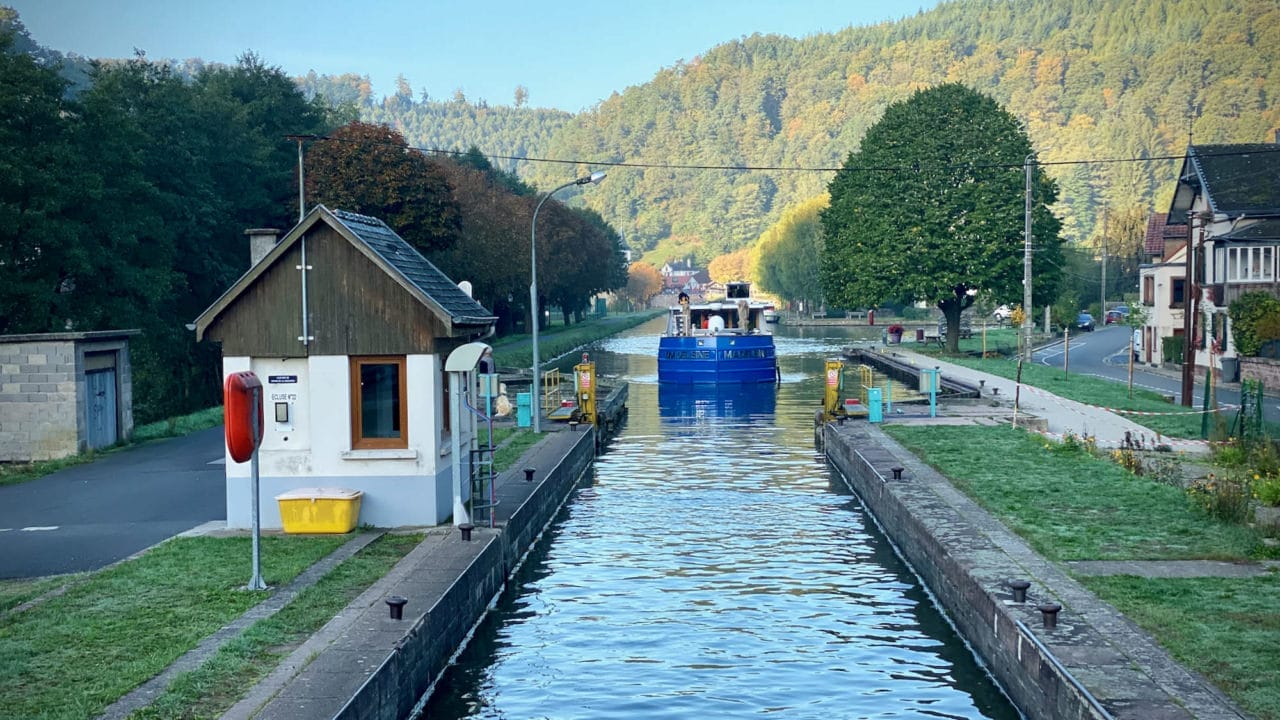
Make no mistake—barge cruises and river cruises are entirely different experiences. While they both float through Europe’s waterways, that’s about where the similarities end. Think of river cruising as a mobile boutique hotel spanning countries, while barge cruising is more like a week at a cozy countryside inn that just happens to float.
What River Cruises Offer
Modern river cruise ships are built to navigate Europe’s major rivers and their long, narrow locks—often more than 600 feet long but only 40 feet wide. These ships typically carry 100 to 190 passengers and are designed for covering large distances in style and comfort.
What to Expect on a River Cruise:
- Multi-deck ships: Usually four decks, including a sundeck up top.
- Staterooms: Most offer queen beds (convertible to twins), TV, smart storage, and sleek bathrooms with showers.
- Amenities: Common areas may include a restaurant, lounge, spa, fitness center, and occasionally a small pool or whirlpool. Many ships offer Wi-Fi and bikes for use ashore.
- Itineraries: Cruises may span multiple countries and hundreds of miles, calling on iconic cities and charming villages.
- Inclusions: Some cruises are à la carte, but many are semi-inclusive with wine and beer at lunch and dinner, plus at least one shore excursion per port.
Price Range: From about $400 to $800 per person per day, depending on the ship, itinerary, and level of luxury.
What Barge Cruises Offer
Barge cruises, especially popular in France, are a far more intimate affair. These vessels typically carry just 6 to 22 passengers and focus on quality over quantity—of both miles and amenities.
What Sets Barge Cruises Apart:
- Regional immersion: Barges typically stay within one small region, often traveling less than 50 miles over six days.
- Relaxed pace: The journey is slow and scenic. You can often walk or bike along the towpath and meet the barge at the next lock.
- Intimate experience: Staterooms are smaller but cozy, with private bathrooms. Most barges have one main deck with a combined dining and lounge area.
- All-inclusive luxury: Expect gourmet, chef-prepared meals with fresh local ingredients, paired with fine wines and champagnes. All excursions, transfers, entrance fees, and gratuities are typically included.
- Onboard features: Some barges offer whirlpools, exercise equipment, and bicycles.
- Activities: Optional extras may include hot-air ballooning, horseback riding, wine tastings, golf, and guided tours.
Charters & Solo Bookings: Barges can be chartered by families or groups of friends, or booked by individual travelers—ideally those who enjoy sharing close quarters with like-minded companions.
Price Range: From $350 to over $1,000 per person per day.
Barge Cruise vs. River Cruise: What’s the Difference?
| Feature | Barge Cruise | River Cruise |
|---|---|---|
| Group Size | 6–22 guests | 100–200 guests |
| Atmosphere | Intimate, relaxed | Social, structured |
| Route | Small canals, countryside | Major rivers, larger cities |
| Shore Excursions | Personalized, local experiences | Group tours, set itineraries |
| Cabins | Cozy, fewer amenities, no balconies | Larger, modern features |
Where Do Barge Cruises Go in France?
In 2026, I will host barge cruises in Burgundy, Alsace, and Provence. Explore my hosted barge trips

Burgundy

Alsace & Lorraine

Provence
The Bottom Line
If you’re looking for a structured itinerary with plenty of sights, river cruising may be your ideal match. But if you crave leisurely exploration, personalized service, and fine cuisine in a countryside setting, a barge cruise might be your dream trip.
Either way, both offer unforgettable ways to experience Europe—from its grand rivers to its hidden canals.
Read about Ralph Grizzle’s barge adventures:
- Arles to Sete on CroisiEurope’s Anne-Marie
- Burgundy on French Country Waterways’ Horizon II
- Alsace on European Waterways’ Panache
Barge operators:
Why Travel with Me?
